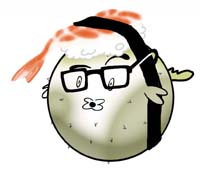
Still No. 1. Japan is still tops when it comes to the mathematical abilities of 15 year olds. According to OECD, when math test scores from 32 countries were tallied, Japan came out on top with 557, a full 10 points above South Korea. Other ranking contenders included New Zealand (537), Finland (536), Australia (533), Canada (533), Switzerland (529), the UK (529), Belgium (520) and France (517). Japan also finished second in physics and eighth in reading comprehension. Nevertheless, it finished at rock bottom in the number of hours spent engaged in homework. Go figure.
Take me out to the (foot)ball game. The World Cup is expected to benefit the Japanese economy to the tune of JPY3.182 trillion, according to the Dentsu Research Institute. This figure is roughly 30 percent above the JPY2.454 trillion that poured into Nagano Prefecture's coffers when it hosted the Winter Olympics in 1998. The same survey also projected that a Japanese victory in the World Cup would generate JPY6.036 trillion. Your finny correspondent's advice: Don't get your hopes up too high.
Closing the gap...slowly. How does China compare with Japan in terms of economic indicators? The March 6 issue of DaCapo magazine raised these examples. China's per capita gross national product in 2000 was $855. (This is roughly on par with Japan's per capita GNP back in 1964, which was $847.) Number of registered passenger cars: 2.07 million in 2000. (Japan's was 1.67 million in 1965.) China's Engel's coefficient (the percentage of income spent on food) was 39.2 percent in 2000. (Japan's was 38.8 percent in 1960.) Infant mortality rates: China 3.1 percent in 1999. (Japan's was 3.1 percent in 1960.) Finally, hosting of the summer Olympic Games (2008 in Beijing -- Japan was 1964) and World Exposition (2010 in Shanghai -- Japan was 1970 in Osaka).
|
Did someone say fish? Subscribers to the mail magazine circulated by the Nihon Keizai Shimbun were asked to name their favorite types of sushi. The results appeared in the newspaper's Saturday supplement earlier this year. A total of 2,273 valid replies were tabulated to come up with the top 10 (with English name and number of votes indicated in brackets). The envelope, please: toro (fatty tuna, 1,227); uni (sea urchin, 713); anago (conger eel, 505); ikura (salmon roe, 429); hirame (flounder, 419); salmon (327); ika (cuttlefish, 314); tai (sea bream, 265); aji (horse mackerel, 262); and maguro akami (regular tuna, 255).
Time to retire? Your company decides to implement restructuring and puts out the word that it's encouraging staff to take early retirement. What will you do? When Internet researcher Micromill posed this question to 1,038 male company employees in the Greater Tokyo area, 51.1 percent said they'd retire if offered a fair deal. But 35.9 percent said they'd hold on until they found a new job first. And, as opposed to the 6.1 percent who said they'd jump at the chance, 5.4 percent said they'd hang on, unless things became absolutely miserable. As a means of preparing for a day they hope will never come, 36 percent are working to refine their job skills to make themselves more useful to their company and another 31.2 percent said they plan to qualify in some type of specialized skill. One out of four replied they are not doing anything in particular. 20.7 percent said they are squirreling cash away, just in case. |
Potpourri. * The most jam-packed commuter train in Tokyo is now the JR Keihin Tohoku Line, whose passenger levels at peak rush hour reach 233 percent (i.e. 2.33 times the supposed capacity) between Ueno and Okachimachi stations. Second worst is the JR Chuo Line express running between Nakano and
Shinjuku.
* The most popular names for baby girls last year were Sakura ('cherry blossom'), Miku ('hence to come') and Nanami ('seven seas').
* The number of patrons at karaoke box establishments has plunged over the past six years, down by 10 million from the 1994 peak of 49 million crooners.
Housebound. With public schools about to shift to the full five-day week, the Ministry of Education, Science, Sports and Culture polled 18,000 primary, junior high and high school students on how they want to spend their Saturdays. Taking the responses from 8th graders, 40.5 percent said they wanted to loaf around the house. This was followed by "go into town to see a movie or shop" (37.3%); watch TV or videos (24.7); play video games or use a PC (23); and chat with family or friends (19.7). In contrast, 1,800 adult subjects replied "straighten up the house" (58.5); go out and meet friends (43.7); take part in sports activities (37.1); relax with family members (34.1); and mingle with nature (28.1).
No carnations for Hanako. The National Institution of Population and Social Security Research, which conducts demographic surveys at five-year intervals, has determined that 8.4 percent of Japanese women in their late 30s who have been married seven years or longer are still childless. The figure, roughly double that of the late 1960s, reflects one of the factors responsible for the decline in the average number of children born per woman to the current 1.39. @
|






